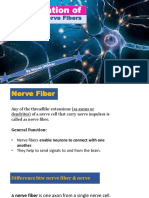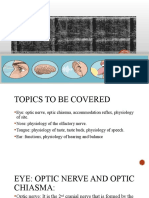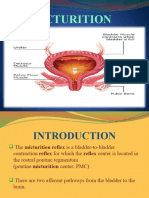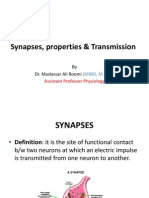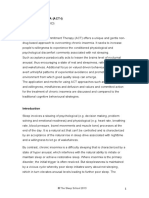3rd Lecture On Nerve Physiology by Dr. Roomi
3rd Lecture On Nerve Physiology by Dr. Roomi
Uploaded by
Mudassar RoomiCopyright:
Available Formats
3rd Lecture On Nerve Physiology by Dr. Roomi
3rd Lecture On Nerve Physiology by Dr. Roomi
Uploaded by
Mudassar RoomiOriginal Title
Copyright
Available Formats
Share this document
Did you find this document useful?
Is this content inappropriate?
Copyright:
Available Formats
3rd Lecture On Nerve Physiology by Dr. Roomi
3rd Lecture On Nerve Physiology by Dr. Roomi
Uploaded by
Mudassar RoomiCopyright:
Available Formats
Nerve physiology
3rd lecture
By Dr. Mudassar Ali Roomi (MBBS, M. Phil)
Inhibition of ExcitabilityStabilizers and Local Anesthetics
the factors that decrease nerve excitability are called as membranestabilizing factors. Calcium local anesthetics:
Examples: procaine and tetracaine. Mechanism of action of local anesthetics: acts directly on the activation gates of the sodium channels, making it much more difficult for these gates to open.
Role of calcium in membrane excitability
Hypercalcemia decrease membrane excitability.*** In hypercalcemia decreased excitability of membrane (also severe constipation).** Hypocalcemia increased excitability of nervous tissue.** Inner side of sodium channels is highly negatively charged. Calcium ions bind with negative inner surface of sodium channels complete closure of activation gates of these channels at rest. So, Calcium (normal levels) stabilizes the membrane and decreases its exciability.
Why tetany occurs in hypocalcemia??
Decreased calcium in ECF no complete closure of activation gates of sodium channels at rest sodium ions leak into membrane from ECF hypo-polarization (membrane potential becomes less negative & near to threshold) & on slight stimulation action potential (tetany).
Why tetany is aggravated in alkalosis?
Protein molecules behave as acid (proton donors become anions) in alkaline pH. At 7.4 (alkaline body pH), protein anions bind positive ions (sodium, potassium, calcium). Protein bound form of calcium increases & ionic form thus decreases tetany.
NERVE FIBER / SKELETAL MUSCLE
CARDIAC MUSCLE
SMOOTH MUSCLE
Multiple peripheral nuclei. Triad is at the junction of A & I bands.
Single central nucleus. Intercalated discs / gap junctions are at the level of Z membranes. (Diad)
Single central nucleus. In some places (intestine), randomly distributed thick & thin filaments interdigitate. Fewer mitochondria. Mostly glycolytic metabolism.
Few mitochondria. Major source of energy is CHO. Glycolysis Citric acid cycle.
More mitochondria (25% mass). Major source of energy is fat (60%) at rest.
Propagation of action potential
Propagation of action potential is an example of positive feedback mechanism. velocity (m/sec) of myelinated fiber = diameter (in mm) x 4.5 velocity of (m/sec) unmyelinated fiber = Square root of diameter
Propagation of action potential in un-myelinated nerve fibers
Point to point conduction. Local circuit of current is formed between depolarized point & adjacent polarized point. Current flowing out through depolarized point, activates Na+ channels at polarized point depolarization action potential. Then a new circuit of current is formed between this depolarized point & adjacent polarized point. In case of unmyelinated nerve fiber, velocity of conduction is slow, because it is point to point. Synapses only allow propagation between pre synaptic to post synaptic neuron inside the body (law of forward conduction). but in vitro it is in both directions.
Myelination Schwann cells surround the nerve axon forming a myelin sheath Sphingomyelin decreases membrane capacitance and ion flow 5,000-fold Sheath is interrupted every 1-3 mm : node of Ranvier
Figure 5-16; Guyton & Hall
Propagation of action potential along a myelinated nerve fiber SALTATORY CONDUCTION
Saltare: to jump Node to node conduction. Internodes are myelinated and act as insulators. Myelin sheath is absent at the nodes of Ranvier & neurilemma at the nodes has got ion channels.
Local circuit of saltatory conduction
depolarized node adjacent polarized node conduction of current through axoplasm and ECF next node is also depolarized
Benefits of saltatory conduction
1. Faster velocity of conduction in large myelinated nerve fibers e.g A-alpha fibers (120 m/sec ). It is very slow (0.5-2 m/sec) in small unmyelinated nerve fibers e.g. type C fibers. 2. Less energy expenditure due to less ionic change 3. Insulation of nerve fibers prevents the short circuiting.
You might also like
- Blood and Cell Physiology MCQs With KeyDocument9 pagesBlood and Cell Physiology MCQs With KeyMudassar Roomi88% (67)
- Endocrine System PhysiologyDocument2 pagesEndocrine System PhysiologyLuisGabitoNo ratings yet
- Water, Electrolyte and PH BalanceDocument6 pagesWater, Electrolyte and PH BalancePitambar PoudelNo ratings yet
- Lecture On Basics of ECG For 1st Year MBBS by Dr. RoomiDocument28 pagesLecture On Basics of ECG For 1st Year MBBS by Dr. RoomiMudassar Roomi100% (3)
- Lecture 1 Blood Physiology by Dr. RoomiDocument24 pagesLecture 1 Blood Physiology by Dr. RoomiMudassar Roomi80% (5)
- Physiology of Limbic System by Dr. RoomiDocument18 pagesPhysiology of Limbic System by Dr. RoomiMudassar Roomi50% (2)
- A Dictionary For Psychotherapists PDFDocument1,375 pagesA Dictionary For Psychotherapists PDFMonica100% (2)
- Adrenal MedullaDocument17 pagesAdrenal MedullahamidNo ratings yet
- Bile SecretionDocument19 pagesBile SecretionMaya Dhakal100% (1)
- Massachusetts Institute of Technology: 6.022J/2.792J/HST542J: Quantitative Physiology: Organ Transport SystemsDocument31 pagesMassachusetts Institute of Technology: 6.022J/2.792J/HST542J: Quantitative Physiology: Organ Transport SystemsZaid AhmadNo ratings yet
- Unit Vii: Regulation of RespirationDocument26 pagesUnit Vii: Regulation of RespirationAnonymous hkWIKjoXFV100% (1)
- Lysosomes and Peroxisomes PDFDocument39 pagesLysosomes and Peroxisomes PDFnagar75100% (1)
- Nerve Physiology 1718 PracticalDocument18 pagesNerve Physiology 1718 PracticalMichael TobilobaNo ratings yet
- General Principles of Tubular ReabsorptionDocument54 pagesGeneral Principles of Tubular ReabsorptionRalph JacintoNo ratings yet
- Hyperosmolar Non Ketotic ComaDocument23 pagesHyperosmolar Non Ketotic Comaprakash gunaNo ratings yet
- Cerebellum MbbsDocument27 pagesCerebellum MbbsCherise Kirkland100% (1)
- LSB658 Clinical PhysiologyDocument27 pagesLSB658 Clinical PhysiologyTess100% (1)
- Enzymology: Discuss About Regulation of Enzyme ActivityDocument4 pagesEnzymology: Discuss About Regulation of Enzyme ActivityNorrifhan Akmal IsmailNo ratings yet
- Classification of Nerve FiberDocument21 pagesClassification of Nerve FiberNayab IftikharNo ratings yet
- Cerebral CirculationDocument16 pagesCerebral Circulationvarrakesh100% (1)
- Blood Gases Mazen 2Document16 pagesBlood Gases Mazen 2Ahmed GaberNo ratings yet
- DR Jagdish Narayan Assistant Professor Department of PhysiologyDocument75 pagesDR Jagdish Narayan Assistant Professor Department of PhysiologyYordanos GetachewNo ratings yet
- Cerebellum ("Little Brain") : 1. General and Regional Organization 2. Internal Structure of The CerebellumDocument16 pagesCerebellum ("Little Brain") : 1. General and Regional Organization 2. Internal Structure of The CerebellummarciaNo ratings yet
- 1st Lecture On The Histology of Female Reproductive System by Dr. RoomiDocument17 pages1st Lecture On The Histology of Female Reproductive System by Dr. RoomiMudassar RoomiNo ratings yet
- Glomerular Filtration: Membrane, Which Consists of A Meshwork ofDocument3 pagesGlomerular Filtration: Membrane, Which Consists of A Meshwork ofPriscilia FooNo ratings yet
- Pancreatic JuiceDocument28 pagesPancreatic Juicefdafasfa100% (1)
- Composition and Function of Blood ComponentsDocument17 pagesComposition and Function of Blood ComponentsPrakash Kumar Nayak100% (1)
- 5 - Physio of Membrane TransportDocument27 pages5 - Physio of Membrane TransportRamadan PhysiologyNo ratings yet
- The Basal Ganglia Mashehabat@just - Edu.joDocument62 pagesThe Basal Ganglia Mashehabat@just - Edu.joSaddamix AL OmariNo ratings yet
- Adrenal CortexDocument8 pagesAdrenal CortexEdward Xiam100% (1)
- M.Prasad Naidu MSC Medical Biochemistry, Ph.D.Research ScholarDocument17 pagesM.Prasad Naidu MSC Medical Biochemistry, Ph.D.Research ScholarDr. M. Prasad Naidu100% (1)
- Tubular Functions of KidneyDocument161 pagesTubular Functions of KidneyPhysiology by Dr RaghuveerNo ratings yet
- 5 HypoxiaDocument42 pages5 HypoxiaShanzayNo ratings yet
- Embryology of CVSDocument63 pagesEmbryology of CVSAdan Iman100% (1)
- Leucocytes 160619161725Document44 pagesLeucocytes 160619161725Rohit K Y100% (1)
- Hormones of The Adrenal Medulla For LabconDocument57 pagesHormones of The Adrenal Medulla For LabconnikkitingNo ratings yet
- Cardiovascular Physiology - 2Document33 pagesCardiovascular Physiology - 2Luiz Jorge MendonçaNo ratings yet
- Physiology of MicturitionDocument44 pagesPhysiology of MicturitionEkiran BabajideNo ratings yet
- Presented By: DR Sharmila G SDocument76 pagesPresented By: DR Sharmila G SSharmila Shivakumar G SNo ratings yet
- Lect 2 Membrane TransportDocument29 pagesLect 2 Membrane Transportramadan100% (1)
- 7 Nervous SystemDocument43 pages7 Nervous Systembabaaijaz01No ratings yet
- Upper LimbDocument90 pagesUpper Limbapi-324160601100% (1)
- Neuroanatomy - Answers and ExplanationsDocument6 pagesNeuroanatomy - Answers and ExplanationsshengziyanNo ratings yet
- Blood Lectures 2014 PIO 205Document84 pagesBlood Lectures 2014 PIO 205Philip Abayomi VincentNo ratings yet
- Body Fluid Compartments 0Document15 pagesBody Fluid Compartments 0Abdo MohdyNo ratings yet
- Transport of Respiratory GasesDocument47 pagesTransport of Respiratory Gasessib786123100% (1)
- Spots For Experimental Pract.Document12 pagesSpots For Experimental Pract.Physiology by Dr RaghuveerNo ratings yet
- Central Nervous System-CNS and Peripheral Nervous System 2Document29 pagesCentral Nervous System-CNS and Peripheral Nervous System 2Noar RamadaniNo ratings yet
- Actions of Thyroid Hormone: Dr. Ayisha Qureshi Assistant Professor MBBS, MphilDocument41 pagesActions of Thyroid Hormone: Dr. Ayisha Qureshi Assistant Professor MBBS, MphilJyoti ChadhaNo ratings yet
- 3 Gaseous Exchange Through The Respiratory Membrane.Document23 pages3 Gaseous Exchange Through The Respiratory Membrane.Ahmed AliNo ratings yet
- Special SensesDocument21 pagesSpecial SensesZeeshan Jalil100% (1)
- Microcytic Hypochromic Anemia: - M QariDocument33 pagesMicrocytic Hypochromic Anemia: - M QarirohitNo ratings yet
- 2.plasma ProteinsDocument5 pages2.plasma ProteinsAnusuya SNo ratings yet
- Juxta Glomerular ApparatusDocument12 pagesJuxta Glomerular ApparatusAisyah Eltufya100% (3)
- Physiology of The Central Nervous SystemDocument43 pagesPhysiology of The Central Nervous SystemSherwan R Shal100% (1)
- Relating Structure To Mechanism in Creatine KinaseDocument21 pagesRelating Structure To Mechanism in Creatine KinaseAnusorn S NiiNo ratings yet
- 04 First Week of DevelopmentDocument70 pages04 First Week of DevelopmentOsman Saidu SesayNo ratings yet
- Key of SEQs Heart, Nerve and Muscle Revision TestDocument11 pagesKey of SEQs Heart, Nerve and Muscle Revision TestMudassar Roomi100% (2)
- Anatomy of External Features of HeartDocument45 pagesAnatomy of External Features of HeartSurajit KunduNo ratings yet
- PSG 252 Lecture 3 The StomachDocument5 pagesPSG 252 Lecture 3 The StomachMichael TobilobaNo ratings yet
- MICTURITIONDocument15 pagesMICTURITIONkazim786ahmedNo ratings yet
- Neuro Muscular Junction NNDocument68 pagesNeuro Muscular Junction NNAnak AyamNo ratings yet
- Nerve & MuscleDocument31 pagesNerve & MuscleHamada BakheetNo ratings yet
- NeurophysiologyDocument44 pagesNeurophysiologyMaria Christina Mendoza GutierrezNo ratings yet
- 2 Origin of Action Potential and Its Propagation Across The Myelinated and Unmyelinated Nerve FibresDocument3 pages2 Origin of Action Potential and Its Propagation Across The Myelinated and Unmyelinated Nerve Fibresshribalaji9810No ratings yet
- GIT Physiology CHAPTER NO 62 Guyton by Dr. RoomiDocument41 pagesGIT Physiology CHAPTER NO 62 Guyton by Dr. RoomiMudassar Roomi86% (14)
- 4th Lecture On Arrythmias by Dr. RoomiDocument11 pages4th Lecture On Arrythmias by Dr. RoomiMudassar Roomi100% (2)
- Physiology of Excitation and Conduction System of Heart by Dr. Mudassar Ali RoomiDocument17 pagesPhysiology of Excitation and Conduction System of Heart by Dr. Mudassar Ali RoomiMudassar Roomi100% (2)
- 1st Lecture On Arrythmias by Dr. ROOMIDocument15 pages1st Lecture On Arrythmias by Dr. ROOMIMudassar Roomi100% (1)
- Lecture On Hemostasis by Dr. RoomiDocument43 pagesLecture On Hemostasis by Dr. RoomiMudassar Roomi100% (1)
- 2nd Lec On Arrythmias by Dr. RoomiDocument12 pages2nd Lec On Arrythmias by Dr. RoomiMudassar Roomi100% (2)
- 3rd Lecture On Arrythmias by Dr. RoomiDocument16 pages3rd Lecture On Arrythmias by Dr. RoomiMudassar Roomi100% (2)
- 3rd Lecture On Arrythmias by Dr. RoomiDocument16 pages3rd Lecture On Arrythmias by Dr. RoomiMudassar Roomi100% (2)
- 1st Lec On Heart Physiology by Dr. RoomiDocument21 pages1st Lec On Heart Physiology by Dr. RoomiMudassar RoomiNo ratings yet
- Lecture 3 Skeletal Muscle Physiology by Dr. RoomiDocument10 pagesLecture 3 Skeletal Muscle Physiology by Dr. RoomiMudassar Roomi100% (1)
- HB Synthesis, Degradation, Jaundice, Iron Metabolism by Dr. RoomiDocument23 pagesHB Synthesis, Degradation, Jaundice, Iron Metabolism by Dr. RoomiMudassar Roomi100% (1)
- 2nd Lecture On Skeletal Muscle Physiology by Dr. Mudassar Ali RoomiDocument29 pages2nd Lecture On Skeletal Muscle Physiology by Dr. Mudassar Ali RoomiMudassar Roomi100% (1)
- Lecture On PHYSIOLOGY of Cerebellum by Dr. RoomiDocument42 pagesLecture On PHYSIOLOGY of Cerebellum by Dr. RoomiMudassar Roomi100% (2)
- Lecture On The Physiology of Neuromuscular Junction (NMJ) by Dr. RoomiDocument18 pagesLecture On The Physiology of Neuromuscular Junction (NMJ) by Dr. RoomiMudassar Roomi100% (3)
- Lecture On Blood Groups, Transfusion, RH Incompatibility by Dr. RoomiDocument41 pagesLecture On Blood Groups, Transfusion, RH Incompatibility by Dr. RoomiMudassar Roomi100% (1)
- Lecture On Anemias and Polycythemias by Dr. RoomiDocument30 pagesLecture On Anemias and Polycythemias by Dr. RoomiMudassar Roomi100% (1)
- Lecture On Basal Ganglia by Dr. RoomiDocument32 pagesLecture On Basal Ganglia by Dr. RoomiMudassar Roomi100% (4)
- Lecture 3 Skeletal Muscle Physiology by Dr. RoomiDocument10 pagesLecture 3 Skeletal Muscle Physiology by Dr. RoomiMudassar Roomi100% (1)
- Lecture 1 Physiology of Skeletal Muscle by Dr. RoomiDocument37 pagesLecture 1 Physiology of Skeletal Muscle by Dr. RoomiMudassar Roomi100% (1)
- Blood and Cell Physiology SEQs KeyDocument11 pagesBlood and Cell Physiology SEQs KeyMudassar Roomi100% (1)
- Lecture Synapses, Properties & Transmission Dr. RoomiDocument22 pagesLecture Synapses, Properties & Transmission Dr. RoomiMudassar Roomi100% (2)
- Lecture On The Physiology of Hypothalamus and Thalamus by Dr. RoomiDocument27 pagesLecture On The Physiology of Hypothalamus and Thalamus by Dr. RoomiMudassar Roomi100% (1)
- Key of SEQs Heart, Nerve and Muscle Revision TestDocument11 pagesKey of SEQs Heart, Nerve and Muscle Revision TestMudassar Roomi100% (2)
- Sense of Touch - Practical by Dr. RoomiDocument14 pagesSense of Touch - Practical by Dr. RoomiMudassar RoomiNo ratings yet
- Respiration Physiology SEQs With KeyDocument12 pagesRespiration Physiology SEQs With KeyMudassar Roomi100% (1)
- Heart, Nerve and Mucsle, Membrane Transport Mcqs With KeyDocument8 pagesHeart, Nerve and Mucsle, Membrane Transport Mcqs With KeyMudassar Roomi100% (7)
- Coursera - Online Courses From Top Universities PDFDocument4 pagesCoursera - Online Courses From Top Universities PDFCelso Ventura Montiel Hernandez0% (1)
- Speech Emotion Recognition Using Deep LearningDocument6 pagesSpeech Emotion Recognition Using Deep LearningInternational Journal of Innovative Science and Research TechnologyNo ratings yet
- Postpartum DepressionDocument3 pagesPostpartum DepressionMelanie GaledoNo ratings yet
- LU5-Introduction To EmotionsDocument26 pagesLU5-Introduction To EmotionsEunmi JeonNo ratings yet
- NICABM Anger Infographic PrintFriendlyDocument3 pagesNICABM Anger Infographic PrintFriendlyShivaprasad Prabhu100% (2)
- Trends L5 Critical ThinkingDocument41 pagesTrends L5 Critical ThinkingSherry GonzagaNo ratings yet
- Bio 30 - Unit A - The EarDocument3 pagesBio 30 - Unit A - The Earapi-582822243No ratings yet
- Functional Behavior AssessmentDocument3 pagesFunctional Behavior AssessmentChangBroot100% (2)
- The Causes and Effects of Impulse Buying (With Comments)Document2 pagesThe Causes and Effects of Impulse Buying (With Comments)Billy Julius GestiadaNo ratings yet
- The Effects of Online Games Towards The Study Habits of Senior High School Students of Maryknoll High School of Asuncion Inc. Survey QuestionnaireDocument6 pagesThe Effects of Online Games Towards The Study Habits of Senior High School Students of Maryknoll High School of Asuncion Inc. Survey QuestionnaireAngelica GementizaNo ratings yet
- Theories of LearningDocument15 pagesTheories of LearningTherese Garcia JalandoonNo ratings yet
- Neurology and Brain Disorders: International Conference OnDocument9 pagesNeurology and Brain Disorders: International Conference OnSumedh VenNo ratings yet
- 重视批判性思维的重要性Document15 pages重视批判性思维的重要性ibodduhjf100% (1)
- 2022 - Porcaro - Diagnostic Developments in Differentiating Unresponsive Wakefulness Syndrome and The Minimally Conscious StateDocument20 pages2022 - Porcaro - Diagnostic Developments in Differentiating Unresponsive Wakefulness Syndrome and The Minimally Conscious Statediasgs.beatrizNo ratings yet
- Neurological Physical ExamDocument3 pagesNeurological Physical Examjyhn24No ratings yet
- Introduction To RulerDocument2 pagesIntroduction To Rulerapi-518552134No ratings yet
- Identifying Information: Psychological Assessment ReportDocument8 pagesIdentifying Information: Psychological Assessment Reportsuhail iqbal sipra100% (1)
- Eye Movements During Text Reading Align With The RDocument18 pagesEye Movements During Text Reading Align With The RPeggy WangNo ratings yet
- Dale's Cone of ExperienceDocument23 pagesDale's Cone of ExperienceJames Marck BabieraNo ratings yet
- Module 5 Regulation of Internal EnvironmentDocument17 pagesModule 5 Regulation of Internal EnvironmentSakshi Jauhari100% (1)
- 6 Supervised NN MLPDocument16 pages6 Supervised NN MLPHaffath AlsayadNo ratings yet
- Animal Behavior - PresentationDocument37 pagesAnimal Behavior - Presentationpedro.runa.diogoNo ratings yet
- Sport Psychological InterventionDocument30 pagesSport Psychological InterventionRafaelAlejandroCamachoOrtegaNo ratings yet
- Psych1 Syllabus Spring2022Document7 pagesPsych1 Syllabus Spring2022BelosnezhkaNo ratings yet
- BOSA Training FAQDocument3 pagesBOSA Training FAQfonokariNo ratings yet
- Mehanizmi Odabrane Kod Zavisnika Od Psihoaktivnih Supstanci Dragana ĐokićDocument14 pagesMehanizmi Odabrane Kod Zavisnika Od Psihoaktivnih Supstanci Dragana ĐokićDragana ĐokićNo ratings yet
- Effects of Addiction To Online GamesDocument18 pagesEffects of Addiction To Online GamesMarco CruzNo ratings yet
- Unit - 3 - Introduction To Basic Listening SkillsDocument3 pagesUnit - 3 - Introduction To Basic Listening Skillsnamrata100% (1)
- Act For Insomnia Act I by DR Guy Meadows The Sleep SchoolDocument7 pagesAct For Insomnia Act I by DR Guy Meadows The Sleep SchoolDharmendra KumarNo ratings yet


















